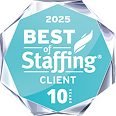Whether it changes due to the COVID-19 pandemic or pressures to reduce operating costs, organizations consistently reassess their employee benefits packages. As we learn more about what it takes to maintain healthy productive employees, population health management has gained more popularity over the last few years.
Today, it’s more commonplace than ever for business to monitor exactly how the workplace impacts people’s overall health. By assessing employee wellness at work, employers show they care about productivity and engagement at the workplace. With population health management protocols, you can increase profitability for your company and boost earnings for employees.
To help clarify exactly how population health management can benefit your operation, CulverCareers put together this brief exploration.
What is Population Health Management?
According to the AHA Center for Health Innovation, “Population health management refers to the process of improving clinical health outcomes of a defined group of individuals through improved care coordination and patient engagement supported by appropriate financial and care models.”
Simply put, population health management works to create health care systems based on information taken from specific portions of the population – such as individual businesses.
No matter the size of your organization, population health management programs must be spearheaded by management and implemented throughout your operation. Next, you must gather data on people’s health – including metrics on such important issues such as primary care visits and employee engagement. The final step is implementing a population health management plan based on the findings from your specific population segment.
Population Health Management Challenges
Before you can really increase employee wellness at your operation, there are certain challenges of population health that you will likely have to address.
Please note, population health management plans differ widely across organizations. Even if you look at a company in a similar field, its likely that their employees face different challenges with health and wellness. That being said, be prepared to create a custom program for your operation.
Once you have a plan in place, it can be difficult to get the data needed to implement appropriate changes in healthcare. Simply put, people are often hesitant to share the details of their medical history and they are not legally obligated to if they don’t see fit. When asking questions and amassing data, be as patient as possible with employees.
Disorganization also tends to plague many new population health management programs. You are well-advised to have organized individuals such as Project Managers involved in the planning process, as much of this type of work is beyond the scope of Human Resources.
Benefits of Population Health Management?
There are many benefits to enacting a population health management plan at your operation. Even better, many of the same protocols that help improve employee health also curb spending on things like sick days, hospital treatments, and high turnover rates.
By helping fill the gaps in your health coverage, population health management ensures a healthier workforce. While you might spend a bit more upfront amassing data and implanting organizational changes, the benefits of this spending by far outweigh the costs.
Implementing preventative medicine at your operation also keeps people healthier and more productive at work. By educating people about important self-care issues like nutrition and stress-relief, you will create a healthier and more productive workforce. This equals less sick days and less employee turnover.
In the plainest financial terms, health wellness programs offer payroll tax savings for employers while also increasing take home pay for employees.
Talk to CulverCareers Today!
A functional population health management plan will not only help protect employee wellness, but will also boost your bottom line. Contact Us today to learn more about overcoming population health challenges.





